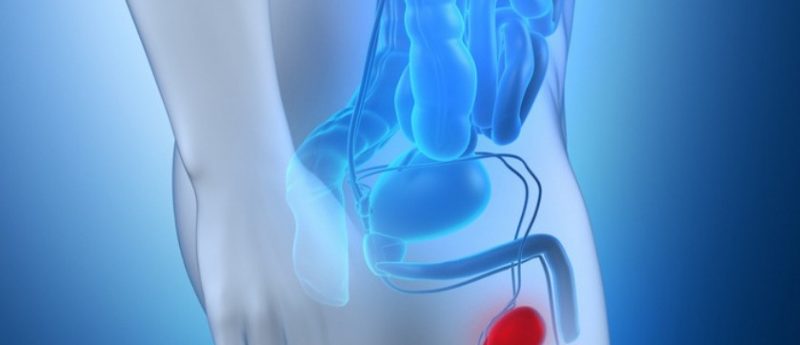Rethinking treatment pathways for prostate cancer

Alastair Henderson, Consultant Urologist at Maidstone & Tunbridge Wells NHS Trust (Kent, UK) and Saheed Rashid, Managing Director, BXTAccelyon (Slough, UK), explain why it is time to reconsider prostate cancer treatment pathways.
Patient choice
Given the recent reinforcement of NICE guidelines for prostate cancer treatment it would be easy to assume that patients are routinely being offered the full range of options [1]. Yet in reality, in prostate cancer, as in any common disease, it is far too easy to fall into standard patterns of treatment that fail to reflect either recent developments or the latest study findings. Too many patients are being offered radical prostatectomy without also being advised on the alternatives, including low-dose rate brachytherapy (LDR-B) which has both a high success rate and offers better long term outcomes in both sexual function and continence.
Closed thinking
Currently, the default position for low-risk cancer is active surveillance and when it comes to prostate cancer treatment, the vast majority of younger patients now receive radical prostatectomy – and in 75% of cases this is now via robotic surgery in the UK; with older patients receiving dose-escalating external beam radiotherapy (DE-EBRT). However, while there is an understandable perception that robotic surgery is significantly more advanced than open surgery, patient outcomes are very similar. While the robotic approach is less invasive and should reduce in-patient time, as well as the risk of a blood transfusion [2], the actual operation is still the standard radical prostatectomy that has been offered for decades.
A recent study published in the New England Journal of Medicine revealed radical prostatectomy has the greatest impairment of sexual function and urinary continence when compared with active monitoring and radical radiotherapy with hormones. In addition, with upwards of 20% positive margins, many radical prostatectomy patients go on to have salvage radiotherapy treatment at a later stage [3]. Questions have to be asked, therefore, why so few patients are being offered alternative treatments – treatments that are part of the overall NICE guidelines – including LDR-B and dose-escalating external beam radiation therapy (DE-EBRT).
Dispelling myths
LDR-B has been an established treatment for prostate cancer for over two decades. It is highly effective offering significantly improved outcomes regarding both sexual function and incontinence. In addition, according to data from the Prostate Cancer Results Study Group, LDR-B treatment achieves 95% of patients disease free at over 10 years [4]. So why are more patients not being offered this option?
One of the issues is without doubt a lack of up-to-date thinking. When first introduced, brachytherapy practitioners adopted a somewhat cautious approach and restricted treatment to low-risk patients. Many patients were also deemed unsuitable if they already had continence problems.
During the past two decades, however, the treatment has moved on significantly and the vast majority of patients are suitable for LDR-B. It offers significant benefits in terms of both process and outcome to men of working age; where LDR-B’s single stage procedure under General Anaesthetic (GA) with a rapid return to work, good potency preservation and lower risk of leakage are key advantages. For the older population the advantages are a less dangerous intervention in terms of in-hospital complications when compared with radical prostatectomy.
Treatment pathways
LDR-B also compares favorably to other treatments, including DE-EBRT. A recent ASCENDE-RT study from Canada, a randomized controlled trial of treatment in men with intermediate- and high-risk prostate cancer, demonstrated a 50% decrease in biochemical relapse with the use of LDR-B in conjunction with hormones and whole-pelvis radiotherapy when compared with using DE-EBRT with the same treatments in patients randomly assigned to the two forms of treatment [5].
It is also important to note that LDR-B has similar levels of morbidity to the active surveillance process which includes regular biopsies under GA. While the NICE guidance about the primary treatment is active surveillance, recent studies reveal that within 3 years approximately 25% of these patients go on to have a definitive treatment and 50% at 10 years [6]. Surveillance is not a curative therapy; it is a monitoring therapy that, in half of all cases, will be followed by treatment. Given that the target population for active surveillance – typically those within the 50-70 years age range – are also the most likely candidates for the curative solution offered by LDR-B, it is important that patients are made aware of the full implications of the surveillance pathway.
There is also a cost consideration – with figures globally revealing that both robotic surgery and evidence based medicine (EBM) are typically twice the cost of LDR-B. Indeed, figures from the ICER study from Harvard University (MA, USA) [7] revealed that LDR-B is not only the most cost-effective curative treatment but is actually almost equivalent to active surveillance in terms of cost of treatment. When adding in the cost of curative treatment for the 50% of patients on active surveillance who go on to require radical intervention, the whole pathway is unlikely to offer any cost saving at all.
4D Brachytherapy
One option that clinicians can also now consider is the latest improvement to LDR-B. 4D brachytherapy is a one-stage, real-time implant technique that uses a simple clinic-based ultrasound scan to calculate the number of stranded and loose seeds required for the procedure. The process offers both better targeted treatment and, through the one-stage process, a better patient experience.
Data from the Royal Surrey County Hospital (UK) comparing the classic two step LDR-B technique with 4D brachytherapy revealed an improvement in potency at 24 months from 65% to 83% of patients. Furthermore, the 4D process enables the delivery of both tighter dose delivery and optimized doses of radiotherapy, further improving implant quality, which is expected to lead to improvements on the current 95% 10-year disease-free control [8].
For patients, the replacement of the traditional volume study procedure undertaken in the operating theater, often under GA, with a simple out-patient procedure significantly improved the experience. For the prostate cancer team, the elimination of the in-clinic volume study also reduces operating theater time. Added together with the reduction in resources and disposables, it is estimated that 4D brachytherapy offers cost savings of 33% compared with the two-step technique.
Conclusion
Radical prostatectomy has been the default treatment for prostate cancer for many years – and the shift from open surgery to robotics has had minimal impact on the overall patient outcome. By contrast, brachytherapy has significantly evolved over the past two decades and has the ability to give a very effective, targeted prescription of radiotherapy, resulting in improvements in already excellent disease control, as well as potency preservation and continence. Critically, it is not – as many believe – limited in its applicability: virtually any patient with localized prostate cancer can receive a brachytherapy implant if that is the desired treatment.
We know the first person men speak to in the counselling process – whether that is an oncologist, urologist or specialist nurse – will have a very strong influence on the eventual decision regarding treatment path. Even patients opting for a second opinion will, more often than not, still follow the advice of the first clinician. It is therefore essential that the first discussion openly and honestly discusses all the potential options – not just radical prostatectomy. Today, while the NICE guidelines include LDR-B, radical prostatectomy, radiotherapy or surveillance – with the emphasis on surveillance first if safe –the treatments being offered to patients are highly postcode dependent [1].
Patient choice is key – and that demands accurate, informed discussion about the pros and cons of every treatment, from outcomes to process. All of the treatments approved by NICE clearly have a role to play in successfully treating prostate cancer. However, before a patient is pushed straight to radical prostatectomy, with all its negative side effects, the full breadth of options, including both LDR and 4D brachytherapy, should be discussed in detail with every patient.
References:
[1] NICE Guidelines Prostate cancer: diagnosis and management www.nice.org.uk/guidance/cg175
[2]Yaxley JW, Coughlin GD, Chambers SKet al. Robot-assisted laparoscopic prostatectomy versus open radical retropubic prostatectomy: early outcomes from a randomised controlled phase 3 study doi: 10.1016/S0140-6736(16)30592-X , The Lancet Vol 388, (2016)
[3] Donovan JL, Hamdy FC, Lane JA et al Patient-reported outcomes after monitoring, surgery, or radiotherapy for prostate cancer N. Eng. J. Med. doi: 10.1056/NEJMoa1606221 (2016)
[4] Prostate Cancer Results Study Group (PCRSG) https://media.wix.com/ugd/71e412_0e4d29f0c6dc42a599193e3e6d760cd4.pdf
[5] Morris JW, Tyldesley S, Rodda S et al Androgen Suppression Combined With Elective Nodal And Dose Escalated Radiation Therapy (the ASCENDE-RT Trial): An analysis of survival endpoints for a randomized trial comparing a low-dose-rate brachytherapy boost to a dose-escalated external beam boost for high- and intermediate-risk prostate cancer doi: 10.1016/j.ijrobp.2016.11.026 Int. J. Radiat. Oncol. Biol. Phys. (2016)
[6] Hamdy FC, Donovan JL, Lane JA et al 10-Year outcomes after monitoring, surgery, or radiotherapy for localized prostate cancer N. Eng. J. Med. doi: 10.1056/NEJMoa1606220 (2016)
[7] Ollendorf DA, Hayes J, McMahon P, Kuba M, Pearson SD; Management Options for Low-Risk Prostate Cancer: A Report on Comparative Effectiveness and Value, ICER (2009)
[8] Langley SE1, Laing RW; Royal Surrey County Hospital: 4D Brachytherapy, a novel real-time prostate brachytherapy technique using stranded and loose seeds; BJU Int. doi: 10.1111/j.1464-410X.2011.10824.x (2012)
Financial disclosure: BXTAccelyon is a provider of low dose rate (LDR) brachytherapy and related solutions for hospitals and clinics to treat prostate cancer. The authors have no other relevant affiliations or financial involvement with any organization or entity with a financial interest in or financial conflict with the subject matter or materials discussed in the manuscript apart from those disclosed.
About the authors
Alastair Henderson
Alastair Henderson joined Maidstone and Tunbridge Wells NHS Trust in 2010, as a Consultant Urological Surgeon and set up his private practice mainly at the Spire Hospital in Tunbridge Wells later in 2010.
He was an undergraduate at Imperial College and St. Mary’s Hospital, London completing his training in 1996. He completed a three-year period of research on prostate cancer in 2003, leading to a PhD degree. His postgraduate training was at Guy’s Hospital London as well as other regional hospitals. This included visits to Seattle where Brachytherapy Prostate treatment was pioneered at the Seattle Prostate Institute and over two years at Guys Hospital learning laser, robotic and laparoscopic surgery for kidney and prostate problems.
Saheed Rashid
 Saheed co-founded BXTAccelyon with Malcolm Hughes in June 2013. He has over 27 years UK and International Healthcare experience in senior Sales, Marketing and General Management roles covering both device and pharmaceutical business in Abbott Laboratories, CR Bard, Baxter International, Amersham and Oncura (a business unit of GE Healthcare).
Saheed co-founded BXTAccelyon with Malcolm Hughes in June 2013. He has over 27 years UK and International Healthcare experience in senior Sales, Marketing and General Management roles covering both device and pharmaceutical business in Abbott Laboratories, CR Bard, Baxter International, Amersham and Oncura (a business unit of GE Healthcare).





